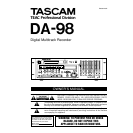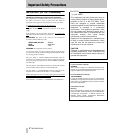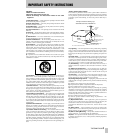
Section 1 – Introduction to the DA-98
1-2 – 1.00 – 06/97
• Shuttle mode enables “rock and roll” audio
positioning of key locations
1.3Using this manual
We suggest that you take the trouble to read this
manual through at least once before starting to use
the DA-98. In this way, you will find out where to
turn when you need answers.
We suggest that you make a special note of the
section 1.4, “Precautions and recommendations”
as these contain some information which is unique
to the DA-98.
We also suggest that you also read 5, “Menu oper-
ations”, as this will help you when you come to
perform basic operations.
When referring to a control or a connector on the
DA-98, the name of the control or connector will
be written in bold type, and will often be followed
by a num ber in brackets, as in the example below:
Holding down the
PLAY
[35] and pressing the
REC
ORD
[36] key will start the recording process.
The numbers refer to the front and rear panel illus-
trations and description in 2, “Front Panel con-
trols” and 3, “Rear Panel connectors”.
When referring to a word or phrase which appears
on the LCD display screen, the word or phrase
will be written as follows:
Move the cursor to .
Sometimes the tape counter is used to display a
message. This will be shown as follows:
The tape counter will show .
1.4Precautions and
recommendations
As with any precision piece of electronic equip-
ment, common-sense precautions apply with the
DA-98.
However, there are a few extra precautions which
apply to the DA-98, and we suggest that you make
a note of these, to prolong the useful life of the
DA-98.
1.4.1Clock source in a digital studio
The DA-98 can be used in a variety of situations,
and with a variety of equipment, either digital or
analog.
If you are working with more than one digital
audio unit in your setup, you should note that all
units must be driven by the same central clock
source (“word clock” or “word sync”).
If different word clock sources are used through-
out the setup, it is actually possible to damage
speakers, etc. because of mismatches.
The DA-98 can be designated as the word clock
master for your studio, or can be slaved to external
word clocks, using a convenient front-panel
switch and standard BNC connectors.
Even though AES/EBU stereo digital audio sig-
nals are self-clocking, any AES/EBU format sig-
nals converted and fed to or from the DA-98 must
be synchronized at word level with the DA-98.
1.4.2Confidence replay
Because the DA-98 can accept digital data and
converts analog data with longer word lengths
than it uses to record on tape (16-bit resolution),
monitoring the input source during recording will
not necessarily provide a completely accurate rep-
resentation of what is recorded on tape.
The DA-98 provides a dither setting (see 8.13.1,
“Selecting dither settings”) which provides
improved total harmonic distortion figures. Since
the dither is applied prior to recording, again,
monitoring the input source will not allow you to
hear the effect of the dithering process.
Accordingly, the DA-98 provides a confidence
mode, allowing you to monitor off-tape as record-
NOTE
Recording is an art as well as a science. A successful
recording is often judged primarily on the quality of
sound as art, and we obviously cannot guarantee that. A
company that makes paint and brushes for artists cannot
say that the paintings made with their products will be
critically well-received. TASCAM can make no guaran-
tee that the DA-98
by itself
will assure the quality of the
recordings you make. Your skill as a technician and
your abilities as an artist will be significant factors in the
results you achieve.


















